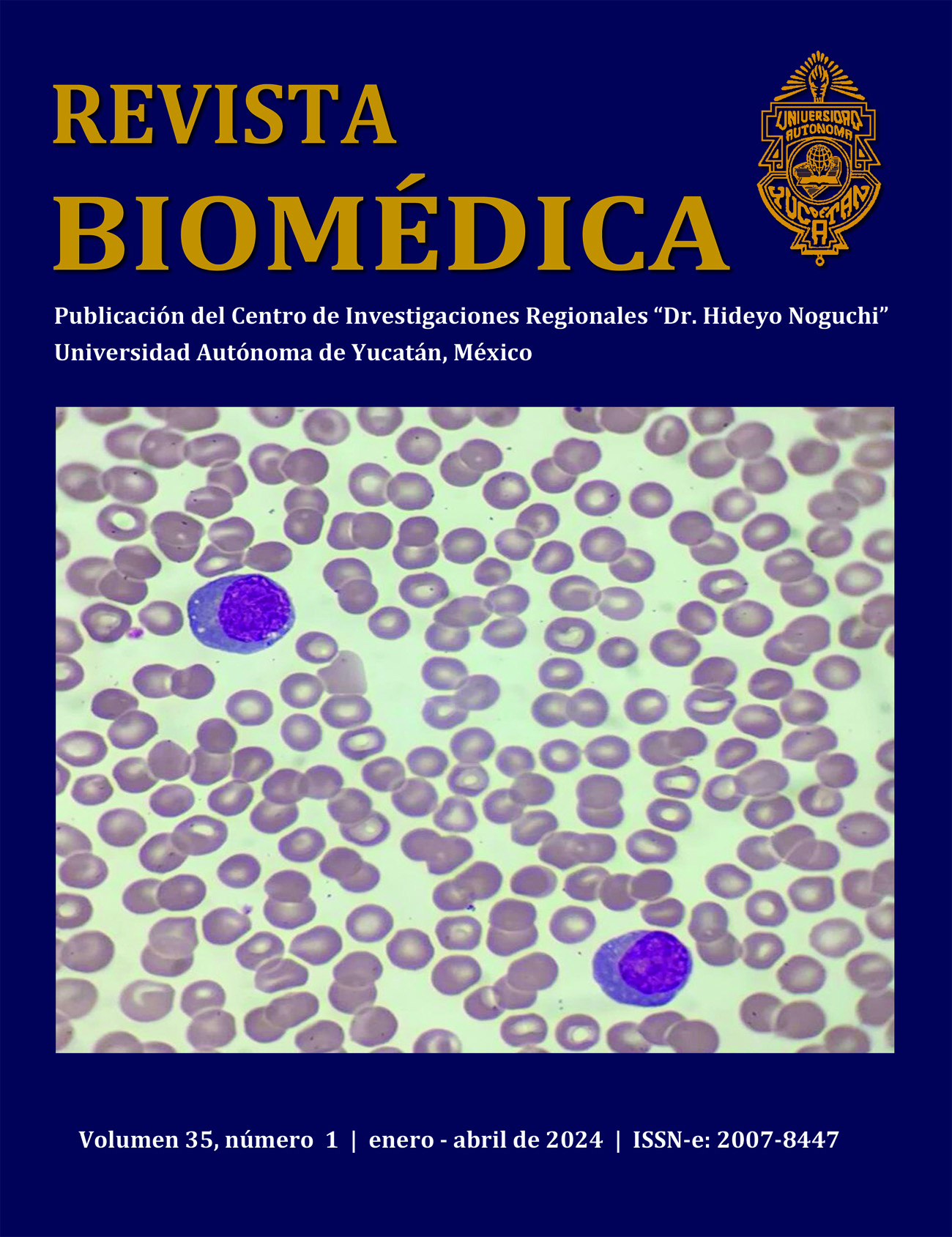Narratives of Patients with Osteoarthritis from Yucatan: A Focus Group Interview Study
Resumen
Introduction: Narrative Medicine serves to accompanying the patient through the experience of illness, listening to his/her story in a simplified therapeutic role. The aim of this interview-based study was to explore in a group of patients with OA from Yucatan the content of their narratives regarding their illness.
Methods: Eight patients with OA participated in five focus group interviews that were tape recorded and transcribed verbatim. Narrative analysis considered the number of mentions and theoretical saturation with three dimensions: pain, stiffness and functional capacity.
Results: Pain was associated with quality of life, religiosity and social interactions. Regarding stiffness and functional capacity, participants expressed the appraisal of illness as an inevitable deterioration and a rather passive coping response.
Conclusions: Narrative-based evidence on how patients with OA perceive and manage their illness underscore health as a concept where the physical and psychological dimensions are in an ongoing interaction; thus, calling for more sensitivity from the medical community and for a comprehensive interdisciplinary treatment.
Referencias
Tanchev P. Osteoarthritis or osteoarthrosis: Commentary on misuse of terms. Reconstr Rev. 2017 Apr;7(1):45–6. doi:10.15438/rr.7.1.178
Atkinson MH. Osteoarthrosis. Can Fam Physician. 1984 Jul;30:1503–7. http://www.ncbi.nlm.nih.gov/pubmed/21278961
Kohler F. Special edition: The International Classification of Functioning, Disability and Health (ICF). Prosthet Orthot Int. 2011 Sep;35(3):259–61. doi: 10.1177/0309364611420995.
Messier SP, Gutekunst DJ, Davis C, DeVita P. Weight loss reduces knee-joint loads in overweight and obese older adults with knee osteoarthritis. Arthritis Rheum. 2005 Jul;52(7):2026–32. doi:10.1002/art.21139
Gregory PJ, Fellner C. Dietary supplements as disease-modifying treatments in osteoarthritis: A critical appraisal. P T. 2014 Jun;39(6):436–52. http://www.ncbi.nlm.nih.gov/pubmed/25050057
Cross M, Smith E, Hoy D, Nolte S, Ackerman I, Fransen M, et al. The global burden of hip and knee osteoarthritis: Estimates from the Global Burden of Disease 2010 study. Ann Rheum Dis. 2014 Jul;73(7):1323–30. doi:10.1136/annrheumdis-2013-204763
Pelaez-Ballestas I, Sanin LH, Moreno-Montoya J, Alvarez-Nemegyei J, Burgos-Vargas R, Garza-Elizondo M, et al. Epidemiology of the rheumatic diseases in Mexico. A study of 5 regions based on the COPCORD methodology. J Rheumatol Suppl. 2011 Jan;86:3–8. doi:10.3899/jrheum.100951
Alvarez-Nemegyei J, Pelaez-Ballestas I, Sanin LH, Cardiel MH, Ramirez-Angulo A, Goycochea-Robles M-V. Prevalence of musculoskeletal pain and rheumatic diseases in the Southeastern region of Mexico. A COPCORD-based community survey. J Rheumatol Suppl. 2011 Jan;86:21–5. doi:10.3899/jrheum.100954
Egnew TR. Suffering, meaning, and healing: challenges of contemporary medicine. Ann Fam Med. 2009;7(2):170–5. doi:10.1370/afm.943
Fioretti C, Mazzocco K, Riva S, Oliveri S, Masiero M, Pravettoni G. Research studies on patients’ illness experience using the Narrative Medicine approach: A systematic review. BMJ Open. 2016 Jul;6(7):e011220. doi:10.1136/bmjopen-2016-011220
Estrella Castillo DF, López Manrique JA, Arcila Novelo RR. Medición de la calidad de vida en pacientes mexicanos con osteoartrosis. Rev Mex Med Física y Rehabil. 2014;26(1):5–11. http://www.medigraphic.com/cgi-bin/new/resumen.cgi?IDARTICULO=51674
Salaffi F, Ciapetti A, Carotti M. The sources of pain in osteoarthritis: A pathophysiological review. Reumatismo. 2014 Jun;66(1):57–71. doi:10.4081/reumatismo.2014.766.
Perrot S. Osteoarthritis pain. Best Pract Res Clin Rheumatol. 2015 Feb;29(1):90–7. doi:10.1016/j.berh.2015.04.017
Zwolak P. Quality of life versus joint stiffness and pains upon movement in lower limb osteoarthritis. Pol Merkur Lekarski. 2014 Feb;36(212):92–5. http://www.ncbi.nlm.nih.gov/pubmed/24720103
Jakobsson U, Hallberg IR. Pain and quality of life among older people with rheumatoid arthritis and/or osteoarthritis: A literature review. J Clin Nurs. 2002 Jul;11(4):430–43. http://www.ncbi.nlm.nih.gov/pubmed/12100639
Jensen MP, Chodroff MJ, Dworkin RH. The impact of neuropathic pain on health-related quality of life: Review and implications. Neurology. 2007 Apr;68(15):1178–82. doi: 10.1212/01.wnl.0000259085.61898.9e
Dedeli O, Kaptan G. Spirituality and religion in pain and pain management. Heal Psychol Res. 2013 Sep;1(3):e29. doi:10.4081/hpr.2013.e29
Jegindø E-ME, Vase L, Skewes JC, Terkelsen AJ, Hansen J, Geertz AW, et al. Expectations contribute to reduced pain levels during prayer in highly religious participants. J Behav Med. 2013 Aug;36(4):413–26. doi:10.1007/s10865-012-9438-9
Puchalski CM, Kilpatrick SD, McCullough ME, Larson DB. A systematic review of spiritual and religious variables in palliative medicine. Palliat Support Care. 2003 Mar;1(1):7–13. http://www.ncbi.nlm.nih.gov/pubmed/16594283
Sherman AM. Social relations and depressive symptoms in older adults with knee osteoarthritis. Soc Sci Med. 2003 Jan;56(2):247–57. doi:10.1016/S0277-9536(02)00023-0
Gignac MAM, Backman CL, Davis AM, Lacaille D, Mattison CA, Montie P, et al. Understanding social role participation: What matters to people with arthritis? J Rheumatol. 2008 Aug;35(8):1655–63. http://www.ncbi.nlm.nih.gov/pubmed/18597401
Paskins Z, Sanders T, Hassell AB. Comparison of patient experiences of the osteoarthritis consultation with GP attitudes and beliefs to OA: A narrative review. BMC Fam Pract. 2014 Dec;15(1):46. doi:10.1186/1471-2296-15-46
Yan J-H, Gu W-J, Sun J, Zhang W-X, Li B-W, Pan L. Efficacy of Tai Chi on pain, stiffness and function in patients with osteoarthritis: A meta-analysis. PLoS One. 2013 Apr 19;8(4):e61672. doi:10.1371/journal.pone.0061672
Lauche R, Cramer H, Dobos G, Langhorst J, Schmidt S. A systematic review and meta-analysis of mindfulness-based stress reduction for the fibromyalgia syndrome. J Psychosom Res. 2013 Dec;75(6):500–10. doi:10.1016/j.jpsychores.2013.10.010
Kang JW, Lee MS, Posadzki P, Ernst E. Tai chi for the treatment of osteoarthritis: A systematic review and meta-analysis. BMJ Open. 2011 Sep;1(1):e000035–e000035. doi:10.1136/bmjopen-2010-000035
Lee MS, Pittler MH, Ernst E. Tai chi for osteoarthritis: A systematic review. Clin Rheumatol. 2008 Feb;27(2):211–8. doi:10.1007/s10067-007-0700-4
Nagarathna R, Nagendra H, Ebnezar J, Yogitha B. Effect of integrated yoga therapy on pain, morning stiffness and anxiety in osteoarthritis of the knee joint: A randomized control study. Int J Yoga. 2012;5(1):28. doi:10.4103/0973-6131.91708.
Cheung C, Park J, Wyman JF. Effects of yoga on symptoms, physical function, and psychosocial outcomes in adults with osteoarthritis. Am J Phys Med Rehabil. 2016 Feb;95(2):139–51. doi: 10.1097/PHM.0000000000000408
Selfe TK, Innes KE. Mind-body therapies and osteoarthritis of the knee. Curr Rheumatol Rev. 2009 Nov;5(4):204–11. http://www.ncbi.nlm.nih.gov/pubmed/21151770
Hurley M, Dickson K, Hallett R, Grant R, Hauari H, Walsh N, et al. Exercise interventions and patient beliefs for people with hip, knee or hip and knee osteoarthritis: A mixed methods review. Cochrane Database Syst Rev. 2018 Apr;4:CD010842. doi: 10.1002/14651858.CD010842.pub2
Enlaces refback
- No hay ningún enlace refback.













